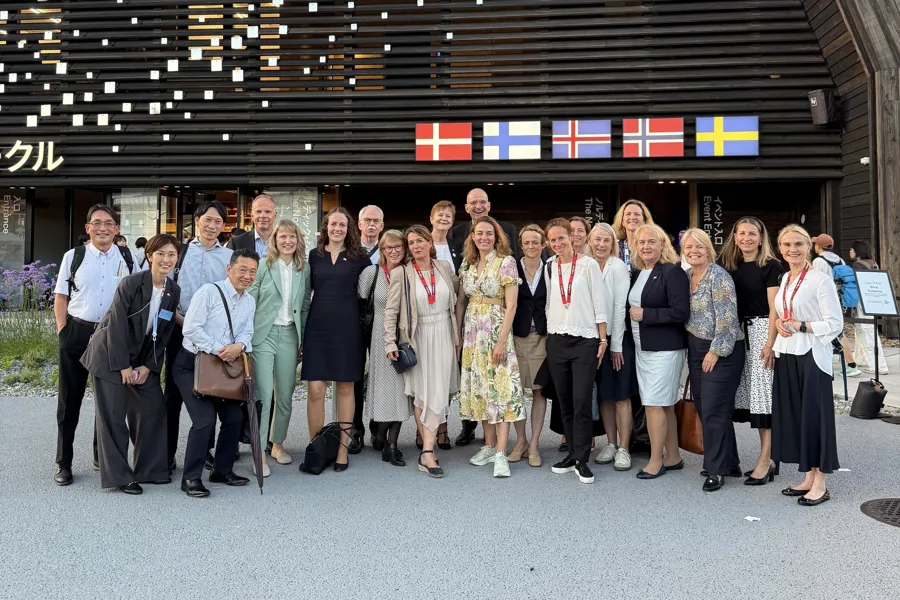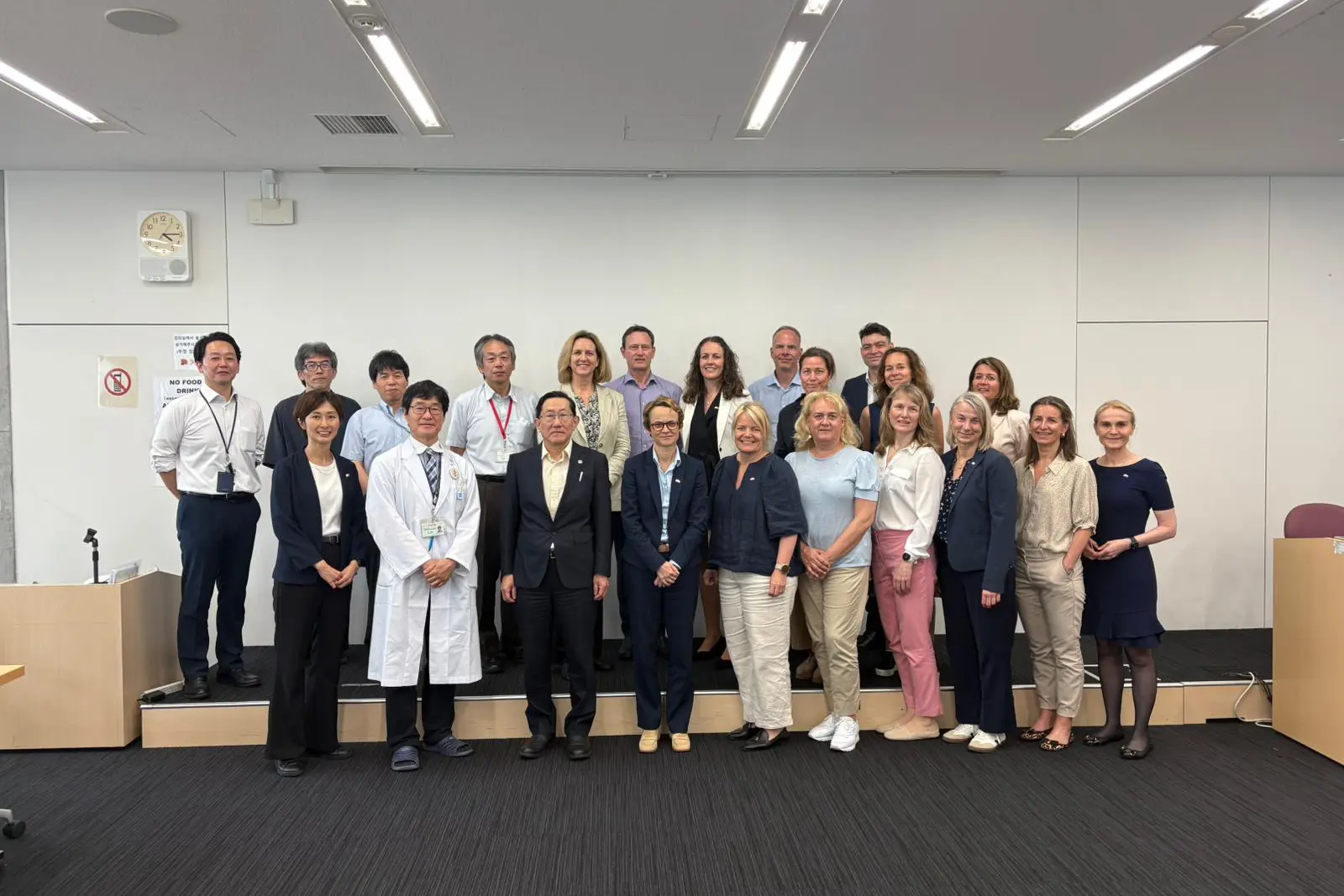Norwegian delegation in Japan to exchange radiopharmacy expertise
A Norwegian delegation spent the entire last week in Japan to exchange experiences in radiopharmacy and precision oncology, with the aim of both business development and clinical studies.

“The trade delegation to Tokyo and Osaka was initiated by Team Norway (Innovation Norway, Oslo Cancer Cluster, and LMI) and is one of the main activities to follow up on the Norwegian government’s export strategy,” writes Tone Varslot Stave, head of the health initiative at Innovation Norway.
Salmon and Radiopharmacy
The delegation included several Norwegian companies that produce radioactive pharmaceuticals, as well as representatives from Oslo University Hospital who have expertise and experience with both radiopharmaceuticals and precision medicine in practice.
“Norway and Japan excel in radiology and radiopharmacy, where theranostics offers precise treatments, reduced side effects, and improved quality of life. We showcased our expertise and connected with the Japanese community. GE Healthcare’s recent inclusion of Nihon Medi-Physics (NMP) made it possible for us to discuss the future of precision medicine,” writes GE Healthcare on LinkedIn.
“We are eager to offer Japanese companies the opportunity to produce their future radiopharmaceuticals in Norway and are confident that the interactions we have had this week will lead to more and closer collaboration going forward,” writes Agilera and CEO Erik Flatmark.
The Trade Mission to Japan aims to showcase Norway’s innovative solutions in radiopharmacy and highlight the potential to address global health challenges — in collaboration with Japanese partners.
Perhaps it’s not just Norwegian salmon in Japanese sushi that represents a win-win collaboration between the two countries.
Differences and Similarities
“Despite the distance, there are several similarities between Japan and Norway, such as an aging population and the same dominant cancer types — prostate, breast, and colorectal cancer,” says Signe Fretland, head of the NorTrials coordinating unit.
One of the differences is the population size; Japan has around 124 million inhabitants compared to Norway’s 5.6 million. Another difference is the attitude towards radioactive pharmaceuticals, explains Monica Larsen, senior adviser at LMI.
“There is greater skepticism towards radioactive medicines in Japan due to the atomic bombings during the war and several accidents at Japan’s nuclear reactors. Therefore, the authorities are particularly cautious when it comes to the use of these drugs. However, despite the skepticism, radioligand therapy and theranostics (combined diagnostics and therapy) are key focus areas in Japan. This is because these medicines have very effective and targeted effects with fewer side effects,” Larsen says.
Among other things, Bayer’s Xofigo, which is on the market in Japan after a somewhat challenging process for Bayer, has provided the authorities with significant experience in radiotherapy.
Busy Visit Schedule
The week in Japan has been both busy and eventful, with visits to government agencies and manufacturing companies, a roundtable meeting with Japanese stakeholders in Tokyo, visits to relevant hospitals, and participation in the World Expo (EXPO) in Osaka.
During the first part of the week, the delegation gained insight into the regulatory situation for the radiopharmaceutical industry, presented by the aforementioned Nihon Medi-Physics (NMP). At a visit to the Pharmaceuticals and Medical Devices Agency (PMDA) — Japan’s drug regulatory authority — they also learned that PMDA collaborates closely with health authorities to streamline the approval of clinical trials and products. Japan offers flexible and predictable regulatory frameworks, including for radiopharmaceutical preparations.
The Norwegian ambassador to Japan, Kristin Iglum, welcomed participants as collaboration opportunities on radiopharmaceuticals and precision medicine were discussed during a roundtable meeting featuring contributions from both Japanese and Norwegian representatives. From Japan, participants included representatives from the Ministry of Health, Labour and Welfare, the Japan Radiopharmaceutical Association (JRPA), the Japan Radioisotope Association (JRIA), the National Institutes for Quantum and Radiological Science and Technology (QST hospital), as well as some of the leading companies in the field. In other words, the Norwegian delegation met with the key stakeholders within radiopharmacy in Japan.
From the Norwegian side, Professor Mona-Elisabeth Rootwelt-Revheim presented Norway’s position in radioligand therapy and theranostics, and Agilera, Bayer, and GE Healthcare all gave initial presentations at the roundtable to set the framework for the discussions that followed.
About an hour and a half east of Tokyo is the radiopharmaceutical company PDR Pharma and their production facility in Chiba.
“PDR Pharma is a company engaged in research, development, production, sales, export, and import of radiopharmaceuticals. They have developed 23 drugs for diagnostic use and 8 drugs for therapeutic use, and every day 3,000 doses are shipped from their production site to patients in Japan, Taiwan, South Korea, and other countries,” explains Signe Fretland.
The National Institutes for Quantum Science and Technology (QST) is a national hub for quantum science and technology, established in 2016 after the merger of the National Institute of Radiological Sciences (NIRS) and parts of the Japan Atomic Energy Agency (JAEA).

“At QST’s campus, there is a research institute, a hospital, and facilities for preclinical animal studies. Most of the research focuses on cancer, but they also conduct some work in neurology. They have three cyclotrons available for production,” says Fretland.
Trip to Osaka
In the second part of the week, the delegation moved to Osaka, a city located a few hours southwest of Tokyo. At Osaka University, they have a renowned and world-leading research environment in radiopharmaceuticals, led by Professor Tadashi Watabe. Here, they have close contact with industry, both through the cyclotron supplier collaborating with staff producing their radiopharmaceuticals, and through companies conducting ongoing studies at the hospital maintaining continuous cooperation with their research support unit.
“They currently have two ongoing studies with astatine (At)-211, one on thyroid cancer and one on prostate cancer. We were given a tour of their nuclear medicine department and laboratories where they develop and test the drugs, and we saw the treatment room where all the study patients have received their injections of At-211 and have been monitored throughout the study,” says Fretland.
EXPO 2025
Thursday was reserved for participation in the “Nordic Health Days” at the joint Nordic Pavilion during the World Expo, EXPO 2025. The purpose of a world expo is to bring nations together to find solutions to the most important challenges of our time. The expo takes place on Yumeshima, an artificial island just outside the center of Osaka.
“The Norwegian delegation played an active role in the professional day seminar, with attendees from Japanese industry, healthcare, and government. The Norwegian companies were a central part of the session on sustainable health and production. The main focus of the seminar was how the Nordics and Japan share a commitment to high-quality care, environmental responsibility, and social inclusion in health and production. GE Healthcare and Bayer showcased strong examples of the environmental responsibility these companies take,” says Larsen, who also summarized one of the sessions in her closing remarks.
In the session on precision medicine in cancer treatment, Åse Bratland and Mona-Elisabeth Rootwelt-Revheim from Oslo University Hospital presented the status of precision medicine, nuclear medicine, and radiopharmaceuticals from a national and Nordic perspective. The Norwegian Cancer Society’s Secretary General, Ingrid Stenstadvold Ross, was also an important contributor to the seminar, both with presentations and as moderator, focusing on the patient perspective.
Speed-Dating Between the Nordics and Japan
Before returning home, some members of the delegation also participated in the Nordic Health Summit Japan, where Nordic researchers and innovation actors had the opportunity to speed-date with Japanese health investors and industry representatives.
“This has been a very successful trip, from the perspective of LMI and LMI’s member companies,” says Larsen.
“In terms of clinical trials, Japan is also very advanced, especially within radiopharmacy. I take their healthcare experiences and their way of collaborating with industry as inspiration to bring back to Norway. We hope to follow up with some of the companies we connected with, who may conduct future studies in Norway,” says Fretland.
Norway’s radiopharmaceutical environment is world-class and growing.